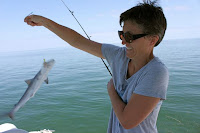How do the survivors of war and disaster move forward? How do they put one foot in front of the other after annihilation? I'm sure I don't know. My own kids recently completed a third grade Guidance unit on Resilience. Their counselor sent home a sheet of tips for parents with ideas for how to make kids more resilient. The basic gist was: Don't freak out so much when bad things happen. Suggestions included smiling and laughing more, yelling less, taking deep breaths and counting to ten, or so. Coping skills. All good suggestions, to be sure, but they sort of failed to address the bigger elephants in the room: illness, death, disaster. There may be no real way to successfully cope with the bigger tragedies we will all encounter sooner or later, but it got me thinking about the best ways to prepare children for life. I started thinking about Dodge.
Mother Nature is a pretty good teacher. Every day, out on the trail with kids, we encounter lessons in resilience. The act of trekking itself builds physical stamina and resilience in kids. We go out every day, regardless of the weather, teaching us that we can cope with the elements. And on our rambles we see countless examples of how the world changes, but persists. We often see parts of animals that have been eaten by other animals and, instead of being alarmed or grossed out, the kids are curious, full of questions and ultimately accepting of the fact of that this is the way things work. A tree falls and rots and becoming food for bugs who become food for birds. Logs turn into dirt and feed other young trees. Buds form on the trees, swell and finally bloom each spring. Sap runs every year, without fail. The snow melts and feeds the pond. Grass greens only to blanch and fade again in the fall. Anticipating new life and subsequent death is implicit in all that we do out there in the field with the kids. There is joy in the new lambs of spring and of course sorrow when a little one just doesn't make it. But we don't shy away from the sorrow, and why should we?
A newly-minted 5-year-old recently shared some of her zen wisdom with me. Keep in mind that this child happens to be one of the most optimistic people I've ever met. I was walking with her, and another 5-year-old friend, on our way to check sap buckets, when she turned to her pal and said, "Do you ever get a funny feeling in your body that bad things happen?"
The other little girl (who happens to be more of a glass-is-half-empty type; it takes one to know one!) turned to her and said, rather ironically, "I don't know what you're talking about."
"You know. You write a story in your journal. You write something bad happening. It gives you a funny feeling, but you still write about the bad thing. My mom says sometimes bad things happen. We talked about it in the car."
The pair continued on in silence. I couldn't help myself and butted in. "But sometimes good things happen too, right? Your dog could give you a kiss. Flowers bloom in the spring."
The young sage spun on her heel and looked me up and down. "Yes, it's true. But, Marlais, dogs poop and flowers die."
You could have knocked me over with a feather. She was so matter-of-fact, her observation so perfectly parallel.
When an older friend of mine, a true mentor to me, died after a terrible reckoning with lung cancer he was cremated. His ashes were spread in his favorite place. The marker that stands as a tribute to his life is inscribed with his own lines of poetry, "Let love / un / balance all." It took me a long time to understand the inscription. For all joy, there is sorrow, but it is how we address the balance, how we tip the scales, that matters. Maybe that is resilience.
Readings On or Around Resilience, A Very Incomplete List
(maybe you would like to post your own readings too)
Strange, sometimes scary, confounding and ultimately engaging:
Totch, A Life in the Everglades by Loren G. "Totch" Brown
Surviving disaster (a bit grisly, not for the faint of heart):
In the Heart of the Sea, The Tragedy of the Whaleship Essex by Nathaniel Philbrick
The Wreck of the Whaleship Essex by Owen Chase
A look at resilience and adaptation through fascinating species study:
The Whale: In Search of the Giants of the Sea by Philip Hoare
The Wild Trees by Richard Preston
The Song of the Dodo by David Quammen
Personal privations:
Pioneer Women: The Lives of Women on the Frontier by Linda Peavy and Ursula Smith
Coming Home Crazy by Bill Holm
The Heart Can be Filled Anywhere on Earth by Bill Holm
Adult fiction of resilience:
O Pioneers! by Willa Cather
Giants in the Earth by OE Rolvaag
The All True Travels and Adventures of Lidie Newton: A Novel by Jane Smiley
Map of the World by Jane Hamilton
The Quiet Girl by Peter Hoeg
Young adult fiction:
The Harry Potter series by JK Rowling
The Penderwicks by Jeanne Birdsall
The Witch of Blackbird Pond by Elizabeth George Speare
Great for kids and adults:
Zen Shorts by Jon J. Muth
Amos & Boris by William Steig
The Story of Ferdinand by Munro Leaf
Miss Rumphius by Barbara Cooney
To Hell With Dying by Alice Walker
Emily by Michael Bedard and Barbara Cooney
